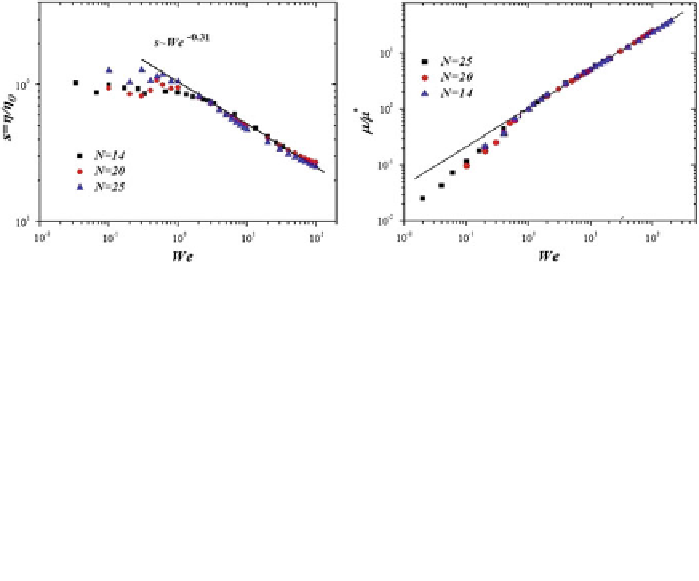Environmental Engineering Reference
In-Depth Information
Fig. 12
(
Left
) Viscosity of the grafted beads of polymer chains forming brushes of three different
polymerization degrees, as a function of the applied shear rate. In order to use dimensionless units
on both axes, the
y
-axis was normalized with the limiting value of the viscosity at zero shear rate
ʷ
0
.
The
x
-axis was normalized with the value of the shear rate when the behavior of the applied force
changes from linear to sub-linear, so defining the Weissenberg number
We
.The
line
is the predicted
scaling law. (
Right
) The friction coefficient is normalized by its value at the transition from linear
to sublinear regimes, as a function of
We
. The friction coefficient for all brushes modeled obeys the
scaling law
μ/μ
∗
∼
We
0
.
69
. See text for details. Adapted from Gama Goicochea et al. (
2014
).
for fluids under flow,
as the one shown in Fig.
11
, using the following relation (Macosko
1994
; Pastorino
et al.
2006
):
One can calculate rheology properties such as the viscosity
ʷ
ʷ
=
F
x
( ʳ)
/
A
.
(16)
ʳ
In Eq. (
16
)
F
x
is the magnitude of the constant force in the
x
-direction, applied
to the planar surfaces of area
A
and
is the shear rate. The brackets represent an
average over the entire simulation time (Gama Goicochea et al.
2014
; Pastorino et al.
2006
). By changing the applied force one can vary the shear rate and then measure
the dynamic response of the fluid through the viscosity using Eq. (
16
). Newtonian
fluids are characterized by viscosities that are independent of the shear rate, but most
fluids of interests for modern applications, as well as the fluid simulated and shown
in Fig.
11
, are of the non-Newtonian type, namely they have viscosities that are shear
rate dependent (Macosko
1994
). Another rheological property of interest for polymer
brushes is the friction coefficient between the brushes and the fluid, which is given
by the following expression:
ʳ
μ
=
F
x
( ʳ)
F
z
( ʳ)
,
(17)
F
x
( ʳ)
F
z
( ʳ)
where
represent the mean forces that the grafted beads expe-
rience along the direction of the flow (
and
z
), respectively.
The brackets symbolize time averages over all the particles in the simulation box.
Clearly,
x
) and perpendicularly to it (
dž
dž
is a dimensionless number. Figure
12
shows the predictions for the vis-
cosity and the friction coefficient obtained from DPD simulations of Couette flow
for linear polymer brushes of varying polymerization degree under theta solvent
μ

Search WWH ::

Custom Search